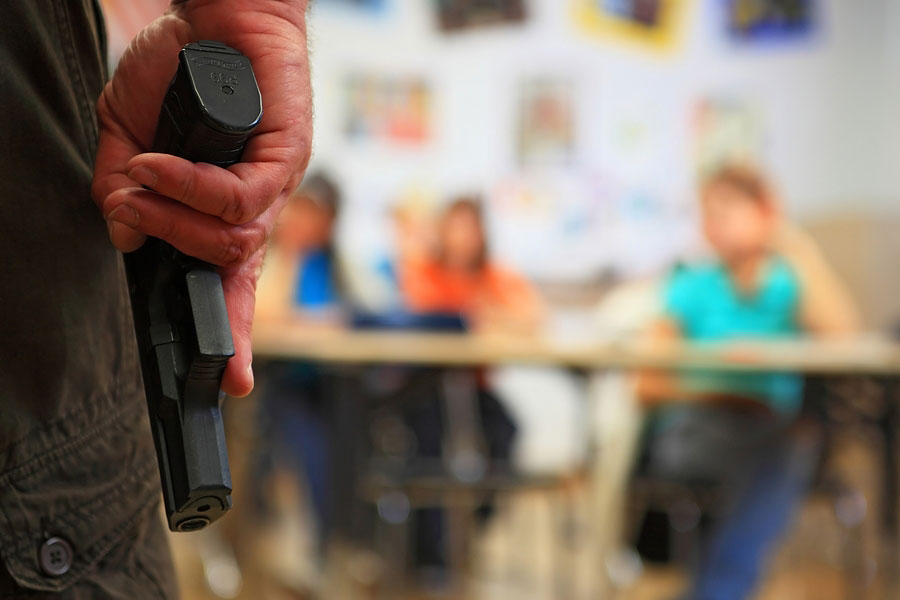Church Safety Teams and Active Shooter Training

Unfortunately, churches must face that we live in dangerous times. There is always the possibility your church will be faced with human threats. The headlines today are filled with stories of violence against churches. While the attacker often belongs to the congregation, sometimes they live in the area or are even complete strangers. Church Safety Teams must know how to handle these types of threads including active shooter training.
Important Terms
Active Killer
An active killer uses firearms or explosives to kill as many people as they can in a building or populated areas. These killers are unpredictable and generally have no pattern to their selection of victims. Active killers start suddenly and escalate quickly and they often don't stop until confronted (United States Department of Homeland Security [DHS], 2008, p. 2).
Cover and Concealment
Cover is an object that stops bullets like a cinderblock wall. Concealment describes anything that will hide a person from view. Large plants, interior walls, and office furniture are examples of concealment.
Soft Target
Soft target describes a person or location that is unprotected or vulnerable, especially to terrorist attacks. Why do churches fall into this category?
- Service times are publicly posted and easy to find.
- Churches stand for a religious truth many find narrow-minded or offensive.
- Many churches in the US are gun-free zones.
- They are open to the public with open access.
- Most have no Safety Ministry
Soft Lockdown/Lockout
When the active killer is outside of the building exterior doors are locked to keep the killer from entering.
Lockdown
An active killer is in the building and the interior rooms are secured with people sheltered inside.
Fatal Funnels
Some hallways prevent the active killer from moving side to side. Containment teams limit the active killer's movements and more easily neutralize him.
Unification Point
Evacuated people meet at unification points. Select multiple locations removed from the setting of the active killer.
Mindset
Mindset enhances survival potential. A strong mindset allows a foundation upon which to base decisions and actions and enables quick and effective thinking and action. With the proper mindset, people trust their intuition: the gut feeling of knowing the right thing to do in a situation.
Active Shooter Training: First Steps
As with all other matters of safety, planning can prevent an attack or mitigate the damage done by one.
Conduct a Facility Assessment
Conduct a facility assessment to determine any problems that could arise during an active killer scenario.
Access
Assess access points including doors, windows, roof latches, etc. Also, assess how doors are locked and secured. Seek out problem areas and identify:
- doors that are easy to force open
- doors that have windows without security mesh/glazing
- exterior windows lacking glazing
Consider items that assist with securing doors like added locks. Even something as simple as placing large planters around the church prevents vehicles from crashing into the building.
Security
Assess existing facility security components. Do closed-circuit televisions, alarms, and perimeter lighting all work?
Communication
Identify and assess existing modes of communication. Information is vital during emergencies so include in your assessment the ways in which you can communicate including two-way radios, your PA system, texting, digital signs, and social media. A good plan includes solid notes on how communications are handled.
Develop Lockout and Lockdown Plans
Lockout
This plan only requires securing exterior access points and keeping everyone in the building. Triggers for lockouts include warning from the potential shooter or another reliable source, law enforcement, or even a security issue nearby. For example, a local bank robbery can cause your church to lockdown. This prevents a hostage situation.
One option to consider in a lockout plan is moving everyone not handling critical job functions to identified secure areas.
Finally, monitor security cameras. Do not open perimeter doors or gates to anyone.
Lockdown
Developing a lockdown plan requires in-depth knowledge of your church's detailed site map or floor plan. When building this plan consider the following:
- Are secondary locking devices needed?
- How will you communicate with each classroom and other areas?
- Are you able to watch the intruder on cameras so you can alert dispatch to where the intruder is?
- Where can you station containment team members using the cover, concealment, and fatal funnels?
- What are good avenues of approach for the engagement team?
- Is there a way to circle behind the shooter?
- Where are places for good cover and concealment while approaching the shooter?
Create plans that include details like, "If a shooter is in the lobby, teach member #1 approaches down the west hallway. Team member #2 approaches from the sanctuary."
Train your staff in the proper use of medical equipment and first aid kits and make sure there are first aid kits placed strategically around the church.
Make sure that you have a plan for resuming normal operations after the lockout or lockdown and know how you will let people know it's over and whether you'll resume operations that day or wait until the next to restart activities.
Team Skills for Emergency Situations
In the event of an active killer, people need to evacuate, hide, call for help and sometimes, engage.
Evacuate
People often react with surprise when they find out that evacuation is now considered one of the most important responses to an active killer. They think of those rare occasions when a second person is waiting outside to ambush. Fewer than 2% of identified active shooter incidents involved more than one killer.
Active shooter training and evacuation planning must include practice evading detection and escaping the building. This includes routes they may not have thought of before. It's been found that people rarely think of back doors or windows as escape routes.
Hide
Everyone should know the basics of hiding.
- Choose rooms that allow freedom of movement. A room with a second door leading to another area of the church or a window provides evacuation options.
- Barricade doors in a lockable room.
- Hide behind objects that serve as cover if possible, otherwise, stay concealed.
- Close and cover interior windows.
- Remain quiet and silence phones, including vibrate.
- Spread out throughout the room.
Call for Help
The United States Department of Homeland Security (DHS) (2008) advises providing the following information when calling law enforcement:
- Location of the active killer
- Number of killers (if more than one)
- Physical description of the killer
- Number and type of weapons held by the killer
- Number of potential victims
Engage the Active Killer
Train your team on how to swarm an active killer with one or two people grabbing each of the killer's arms and legs. Teach them how to remove and secure the killer's weapon.
Create Engagement and Containment Teams
Prepare for both types of response plans: engagement and containment. The engagement team deescalates the situation and prepares to use force. The containment team, on the other hand, moves people from the area and initiates lockdown.
Members of these teams must understand that the decision to join either of these teams is a risk.
Conduct Active Shooter Training and Drills
Mock violent intruder training exercises build understanding and confidence. Use local law enforcement as a resource for designing training exercises. They will teach you and your congregation to:
- Recognize the sound of gunshots
- React quickly to gunshots
- Evacuate the area
Make sure training includes:
- Evacuation
- Hiding
- Helping treat injured
- Calling 911
- Acting against the killer
- Reacting when law enforcement arrives
- Adopting a survival mindset
The Truth about Active Killers
If a bad guy is determined, he will get into your church. Encourage people not to submit. Passive or stationary targets are easy victims. In the 2007 Virginia Tech shooting, for example, students were advised by the university to "Please stay put" (CNN, 2016). Students followed the directive and sat in their chairs as the killer shot one at a time. Even as the shooter reloaded they stayed in their seats (Grossman, 2012).
Another truth? These incidents usually last only a few minutes.
During an Attack
When an active killer starts shooting, everyone will be caught unaware. The sooner people know what's happening it's important to act.
Staff, Guests, and Children
Staff, Guests, and children should follow these steps in this order.
Evacuate
People should get out. Leave everything behind. Help others if you can, but go without them if they will not join you in evacuating. On your way out stop others from going into the dangerous area.
Hide
Use cover and concealment to your advantage. Rooms with more than one exit are best so that you can escape through one exit if the intruder comes from a different one.
Call for Help
When it is safe to do so, call 911. If you can't speak, leave the line open to 911 so the dispatcher can hear what's going on. When it's possible, provide as much information as possible to the dispatchers.
Learn more about this topic and several others with our Certified Safety Member Course. It is available as an online video-based training that can be taken anytime and from anywhere using your own computer. Each section ends with a short test to demonstrate an understanding of the material. Once you've completed all 7 sections, you will be certified for 2-years with Sheepdog Church Security.
Take Action
Evacuation is the primary goal but sometimes people have to engage the killer. If confronted, take action. Your life is in danger. Do what you can to disrupt or interrupt:
- Try to escape
- Cause distractions by yelling
- Throw whatever is near you at the intruder's face
- Use anything available as a weapon
- Get others to swarm the intruder, going for his limbs
- Never comply with an active killer's demands and do whatever it takes to survive.
Safety Team Response
Any person who responds to an active killer situation, like members of a safety team, put their life in great danger. This is an individual choice and cannot be dictated by anyone. Sheepdog Church Security strongly encourages the following requirements to be met by all armed people:
- Meet minimum legal requirements to carry a firearm
- Familiar with the use of force laws and policy
- Sufficiently trained to use their firearms in a tactical situation
If You have Warning/A Potentially Violent Person has Been Identified
Immediately call 911 when a person shows potential for violence. Never fear to call the police. It is better to have the police respond before violence erupts. After calling 911, initiate lockdown. If the intruder is in the building, leave exterior doors open so police can enter.
Try to deescalate the person verbally and if it's working, stick with this. If it is not working, use self-defense techniques. Consider swarming the subject or using a non-lethal weapon like defensive spray.
Use force only as a last resort if absolutely necessary. Do so (in accordance with the law of your state) to neutralize the threat. Position armed persons where they have clear lines of sight to the intruder. Be aware of who is around the active killer. Never shoot into a crowd. Anyone armed must consider all options for cover, concealment, and maneuverability. Members should constantly ask themselves, "If I am taking heavy fire, how can I escape?"
Presenting or pointing a firearm at an intruder has legal implications and often triggers a violent response. It slows your ability to respond with self-defense techniques because you'll have to first holster your weapon. If you're able to physically approach, a swarm is often the best option.
If You Don't have Warning/Active Killer Incident Happens Suddenly
When there's no warning, activate your engagement team. The engagement team moves toward the target to neutralize the threat. While doing so, they advise others to go into lockdown or evacuate the area. People should be moved as far away from the sound of gunshots as possible.
The engagement team continues moving toward the sound of gunshots using cover and concealment, being especially careful going around corners. Their goal is to neutralize the threat using whatever force is necessary. Meanwhile, the containment team takes position preventing the threat from entering populated areas of the church. Containment team members should find a food position of cover and take advantage of fatal funnels.
Team members are looked to by the congregation. Remain calm. Direct people to evacuation routes and secured areas.
After the Intruder is Neutralized
After neutralizing the active killer the engagement team holsters their firearms. This is especially important because law enforcement will not know who the shooter is. Other next steps include:
- Notifying the containment team and 911 dispatch that the threat has been neutralized. Do not consider that the police know this upon arrival (See above note about firearms).
- Contact the church staff to let them know the threat has been neutralized.
- Maintain lockdown until the police advise you to lift it.
- Provide medical aid to injured people. Always treat the most severe injuries first. Only treat the intruder if it is safe to do so. He may have other weapons.
- When medical personnel responds, clear the way for them and only provide assistance if it is specifically requested of you.
- Evacuate to unification areas.
The containment team should also holster their firearms immediately after the killer is neutralized and then follow these same steps.
When Law Enforcement Arrives
Training must include what to do when law enforcement arrives. We've taken this information from the Department of Homeland Security (2008):
- Officers will usually arrive in teams of four wearing tactical equipment.
- They may be armed with rifles, shotguns, and handguns.
- Pepper spray or tear gas may be used.
- Officers may shout commands and even push individuals to the ground. These actions are for everyone's safety.
Your congregation should be aware that their role is to:
- Remain calm and follow all police instructions.
- Put down any items in their hands, raise hands, and spread fingers.
- Keep hands visible at all times
- Avoid making quick movements toward officers such as grabbing onto them. Avoid pointing, screaming, and yelling.
- Proceed in the direction from which officers are entering the premises, not ask questions or for help.
Congregants should also know that the first officers are there to neutralize a threat and will often not stop to help the injured. Rescue teams and emergency medical personnel will follow the initial officers. These rescue teams will treat and remove any injured persons. They may also call upon able-bodied individuals to assist in removing the wounded from the premises. Once you have reached a safe location or an assembly point, you will likely be held in that area by law enforcement until the situation is under control, and all witnesses have been identified and questioned. Do not leave until law enforcement authorities have instructed you to do so (DHS, 2008, p. 5).
Planning for the Future
We pray that you never go through an active killer attack. If you do, we encourage you to contact us. We'll help you assess how your team was effective and what to consider for the future.






